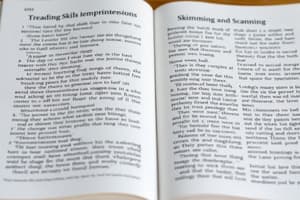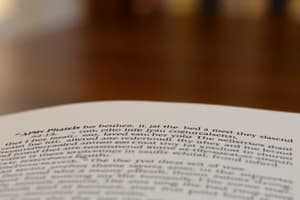Podcast
Questions and Answers
Describe the primary difference between skimming and scanning.
Describe the primary difference between skimming and scanning.
Skimming involves quickly reviewing a text to get a general understanding of the content, while scanning focuses on rapidly searching for specific information within the text.
What type of reading would be most appropriate for a student preparing for an exam on a historical event?
What type of reading would be most appropriate for a student preparing for an exam on a historical event?
Intensive reading.
Explain why extensive reading is beneficial for developing language skills.
Explain why extensive reading is beneficial for developing language skills.
Extensive reading exposes readers to a wide range of vocabulary and grammatical structures, promoting language acquisition and fluency.
What is the primary goal of skimming a text?
What is the primary goal of skimming a text?
Identify two reading strategies commonly used in skimming.
Identify two reading strategies commonly used in skimming.
Explain the key difference between literal reading and inferential reading, providing an example for each.
Explain the key difference between literal reading and inferential reading, providing an example for each.
What are the key elements considered when engaging in critical reading, and how does it differ from appreciative reading?
What are the key elements considered when engaging in critical reading, and how does it differ from appreciative reading?
Describe a scenario where skimming and scanning are essential reading strategies, and explain why.
Describe a scenario where skimming and scanning are essential reading strategies, and explain why.
Explain how extensive reading strategies contribute to overall reading proficiency.
Explain how extensive reading strategies contribute to overall reading proficiency.
Identify the different reading types that might be employed while studying a history textbook, and explain the rationale for each.
Identify the different reading types that might be employed while studying a history textbook, and explain the rationale for each.
Provide two different examples of how reading types can be assessed, focusing on both comprehension and engagement.
Provide two different examples of how reading types can be assessed, focusing on both comprehension and engagement.
How does optimizing reading experiences contribute to improved comprehension and analysis?
How does optimizing reading experiences contribute to improved comprehension and analysis?
Explain how the various reading approaches can be utilized to facilitate efficient learning and skill development in diverse contexts.
Explain how the various reading approaches can be utilized to facilitate efficient learning and skill development in diverse contexts.
Flashcards
Skimming
Skimming
Quickly reviewing text for a general idea of content.
Scanning
Scanning
Rapidly searching for specific information in a text.
Extensive Reading
Extensive Reading
Reading large amounts of text for pleasure and language skills.
Intensive Reading
Intensive Reading
Signup and view all the flashcards
Reading Strategies
Reading Strategies
Signup and view all the flashcards
Literal Reading
Literal Reading
Signup and view all the flashcards
Inferential Reading
Inferential Reading
Signup and view all the flashcards
Critical Reading
Critical Reading
Signup and view all the flashcards
Creative Reading
Creative Reading
Signup and view all the flashcards
Appreciative Reading
Appreciative Reading
Signup and view all the flashcards
Purpose in Reading
Purpose in Reading
Signup and view all the flashcards
Skimming and Scanning
Skimming and Scanning
Signup and view all the flashcards
Importance of Reading Types
Importance of Reading Types
Signup and view all the flashcards
Study Notes
Introduction
- Reading is a complex cognitive process involving decoding and comprehension
- Different types of reading serve different purposes and require varying levels of engagement and skill
- Understanding these types can improve reading strategies and outcomes
Types of Reading Based on Purpose
- Skimming: Quickly reviewing text to get a general idea of the content
- Used for finding specific information or understanding the overall structure of a document
- Involves focusing on headings, subheadings, introductions, conclusions, and key words
- Speed and efficiency are key
- Scanning: Rapidly searching a text for specific information
- Aims to locate answers to questions, specific details, or keywords
- Not concerned with understanding the overall text but with locating answers
- Focus on keywords or phrases helps locate information quickly
- Extensive Reading: Reading large amounts of text for pleasure and to develop language skills
- Purpose is enjoyment and learning from varied sources
- Reading strategies are not as focused on comprehension depth as speed, which can be helpful for vocabulary development
- Intensive Reading: Reading closely and critically to fully understand the meaning of a text
- Purpose is to analyse and understand the text, and it requires close attention to details
- Often used for academic purposes, professional contexts, and literary works with an emphasis on interpretation.
Types of Reading Based on Approach
- Literal Reading: Focusing on the explicit meaning of the text
- Key skill is accurately transferring the information from the text to the reader
- Understanding facts, details, and events as they are presented
- Inferential Reading: Inferring meaning from the text by drawing conclusions from the information provided
- Reading between the lines and looking for implied ideas
- Critical Reading: Evaluating the author's purpose, message, and assumptions
- Analyzing the validity, credibility, and biases present in the text
- Examining evidence and arguments
- Creative Reading: Imaginative and personalized interpretation of a text
- Embracing different perspectives through the author's text to provide a unique interpretation
- Often used in literary analysis and personal reflection
- Appreciative Reading: Focus on understanding and appreciating the artistry and beauty of a text
- Often related to literature, where emphasis is on imagery, tone, language, and literary devices
Factors Influencing Reading Types
- Purpose: What the reader intends to achieve
- Text type: The format and structure of the text (e.g., novel, article, news report)
- Reader's knowledge: Prior understanding of the topic and relevant vocabulary
Reading Strategies for Different Approaches
- Skimming and Scanning Strategies: Using rapid eye movements
- Identifying keywords, scanning for specific information e.g. a date
- Extensive reading strategies: Choosing the right material, reading regularly
- Setting time aside for reading, allowing yourself to experience what you are reading
- Intensive reading strategies: Note-taking and highlighting, questioning
- Active interaction with the text, creating connections between the content, and reflecting on the information
- Literal Reading strategies: Understanding text structure, focusing on details and facts
- Identifying main ideas, using evidence to support ideas, summarizing content
- Inferential, critical, and creative reading strategies: Identifying assumptions, analyzing evidence, examining perspectives and making connections.
Assessment of Reading Types
- Assessing comprehension levels and engagement is crucial
- Evaluate the reader's ability to retrieve explicit details
- Identify inferences drawn by the reader
- Evaluate if the reading has been achieved
Importance of Reading Types
- Optimizing reading experiences: Reading proficiency can be enhanced to access information, knowledge, and understanding efficiently.
- Improved comprehension and analysis: Understanding different types of reading can lead to better comprehension, analysis, and evaluation
- Enhanced learning and skill development: The various reading approaches facilitate efficient learning and skill development in diverse contexts
Studying That Suits You
Use AI to generate personalized quizzes and flashcards to suit your learning preferences.




